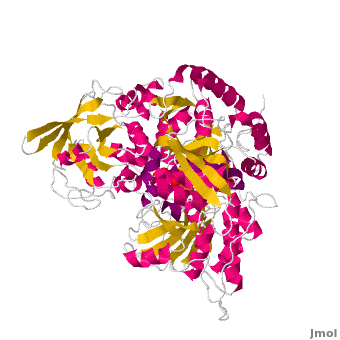Aconitase
From Proteopedia
| Line 1: | Line 1: | ||
| - | <applet load='1pw4.pdb' scene='User:Ralf_Stephan/Sandbox_1/Vertical_symm/1' size='400' frame='true' align='right' caption="GplT from E. coli is a Major Facilitator antiporter, rocker-switch type" /> | + | <applet load='1pw4.pdb' scene='User:Ralf_Stephan/Sandbox_1/Vertical_symm/1' size='400' frame='true' align='right' caption="GplT from E. coli is a Major Facilitator antiporter, rocker-switch type. We use it as example but the principle remains the same for all other Major Facilitators." /> |
| - | ''' | + | '''Major Facilitator''' are membrane proteins that help with both influx and outflux of specific small molecules. They are neither passive channels, nor do they active pumping, like the ATPases. Like a rocker-switch, they tilt between the two states 'outside open' and 'inside open'. This tilting (or switching) is triggered when a molecule has docked inside, and it transports the molecule to the other side. We call these transporters antiporter because, when switching back, usually a second, different, molecule is transported in the opposite direction. Have a look at the complete process involving all molecules. |
| - | The glpT subfamily of transporters consist of several transport proteins from bacteria like ''E. coli'' and ''Salmonella typhimurium'', but also the human glucose-6-phosphate translocase. They all are evolutionary connected and have 12 transmembrane helices that stand together to make an opening between them, | + | As example above, we used the glucose-3-phosphate transpoter (GlpT) from E. coli. The glpT subfamily of transporters consist of several transport proteins from bacteria like ''E. coli'' and ''Salmonella typhimurium'', but also the human glucose-6-phosphate translocase. They all are evolutionary connected and have 12 transmembrane helices that stand together to make an opening between them, not unlike a channel. This channel, however, is unpassable as long as not the right molecule (glucose-3-phosphate in the case of GlpT) is docked into it.<ref>PMID:18537473</ref><ref>PMID:17915951</ref><ref>PMID:12893936</ref> |
== References == | == References == | ||
<references/> | <references/> | ||
Revision as of 07:34, 7 February 2009
|
Major Facilitator are membrane proteins that help with both influx and outflux of specific small molecules. They are neither passive channels, nor do they active pumping, like the ATPases. Like a rocker-switch, they tilt between the two states 'outside open' and 'inside open'. This tilting (or switching) is triggered when a molecule has docked inside, and it transports the molecule to the other side. We call these transporters antiporter because, when switching back, usually a second, different, molecule is transported in the opposite direction. Have a look at the complete process involving all molecules.
As example above, we used the glucose-3-phosphate transpoter (GlpT) from E. coli. The glpT subfamily of transporters consist of several transport proteins from bacteria like E. coli and Salmonella typhimurium, but also the human glucose-6-phosphate translocase. They all are evolutionary connected and have 12 transmembrane helices that stand together to make an opening between them, not unlike a channel. This channel, however, is unpassable as long as not the right molecule (glucose-3-phosphate in the case of GlpT) is docked into it.[1][2][3]
References
- ↑ Law CJ, Maloney PC, Wang DN. Ins and outs of major facilitator superfamily antiporters. Annu Rev Microbiol. 2008;62:289-305. PMID:18537473 doi:http://dx.doi.org/10.1146/annurev.micro.61.080706.093329
- ↑ Law CJ, Yang Q, Soudant C, Maloney PC, Wang DN. Kinetic evidence is consistent with the rocker-switch mechanism of membrane transport by GlpT. Biochemistry. 2007 Oct 30;46(43):12190-7. Epub 2007 Oct 4. PMID:17915951 doi:http://dx.doi.org/10.1021/bi701383g
- ↑ Huang Y, Lemieux MJ, Song J, Auer M, Wang DN. Structure and mechanism of the glycerol-3-phosphate transporter from Escherichia coli. Science. 2003 Aug 1;301(5633):616-20. PMID:12893936 doi:10.1126/science.1087619
Proteopedia Page Contributors and Editors (what is this?)
Michal Harel, Alexander Berchansky, Ralf Stephan, David Canner, Joel L. Sussman, Jaime Prilusky, Anthony Noles, Angel Herraez, Eran Hodis

